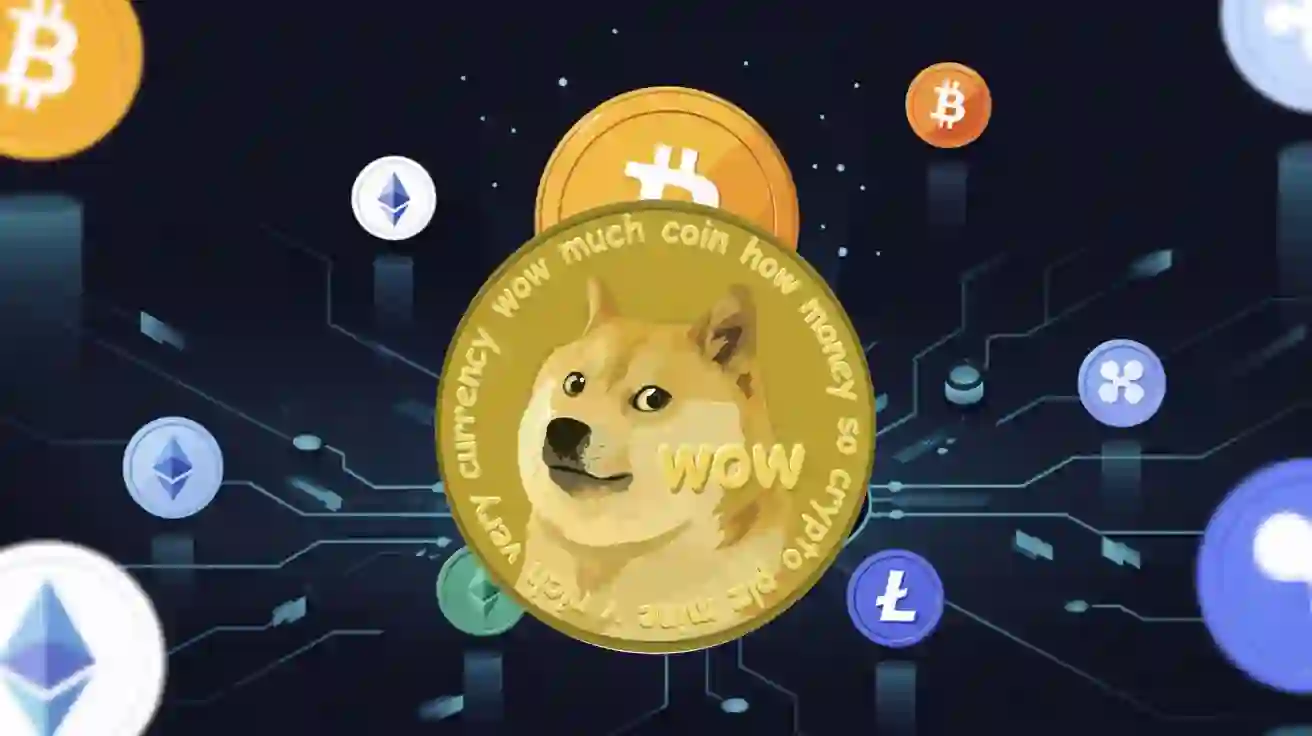In the annals of internet culture, few creations have achieved the bizarre and bewildering trajectory of Dogecoin (DOGE). Born from a fleeting moment of satirical commentary on the burgeoning cryptocurrency scene, this digital token, adorned with the quizzical face of a Shiba Inu dog, defied all expectations. It morphed from a lighthearted jest into a global community, a philanthropic force, a tool for online tipping, a highly speculative asset, and ultimately, a surprisingly resilient player in the volatile world of digital finance. Dogecoin isn’t just a cryptocurrency; it’s a cultural artifact, a testament to the power of memes, and a constant source of fascination and debate, proving that sometimes, the most absurd ideas possess the most unexpected staying power.
Genesis: A Moment of Sarcasm Sparks a Movement (2013)
The year 2013 was a crucible for cryptocurrency experimentation. Bitcoin had established itself, and a wave of “altcoins” – alternative cryptocurrencies – were flooding the nascent market, each promising revolutionary technology or unique features. Amidst this speculative frenzy, Jackson Palmer, an Adobe marketing professional in Sydney, observed the proliferation of often questionable coins with wry amusement. As a satirical jab at the hype, he fired off a now-legendary tweet, stating he was “investing in Dogecoin,” attaching the name to the wildly popular “doge” meme featuring a Shiba Inu dog with comical internal monologues rendered in Comic Sans font. It was pure parody, a coin that didn’t exist, mocking the absurdity he perceived.
Surprisingly, Palmer’s joke resonated. Instead of fading into internet obscurity, the tweet garnered positive feedback. People echoed the sentiment that the crypto space, often perceived as overly serious, technically dense, and sometimes ethically dubious, could benefit from something more approachable and fun. The idea of a friendly, meme-based coin struck a chord.
Enter Billy Markus, a software engineer at IBM in Portland, Oregon. Seeking a project distinct from Bitcoin, Markus had been experimenting with his own digital currency concept. He stumbled upon Palmer’s Dogecoin idea and reached out. Together, almost on a whim, they decided to turn the joke into reality. Markus adapted the code primarily from an existing cryptocurrency called Luckycoin (which itself was derived from Litecoin, a fork of Bitcoin), incorporating the Scrypt hashing algorithm. Within a remarkably short period, Dogecoin, the cryptocurrency born from satire, was launched on December 6, 2013. Neither Palmer nor Markus anticipated what would happen next. They had created it as a side project, a “hobby,” yet almost instantly, a vibrant and dedicated community began to coalesce around their creation.
The Heartbeat of Dogecoin: A Community Unlike Any Other
What truly set Dogecoin apart from the outset wasn’t its technology (which was competent but not groundbreaking) but its community. The subreddit r/dogecoin rapidly became the central hub, fostering an environment renowned for its friendliness, inclusivity, and generosity – characteristics often starkly contrasting with the sometimes combative and cynical nature of other online crypto forums. The community embraced the “doge” meme’s playful absurdity, adopting phrases like “Wow,” “Such coin,” “Much moon,” and the guiding principle: “Do Only Good Everyday.”
This ethos wasn’t just talk. The Dogecoin community quickly gained mainstream attention through remarkable acts of collective philanthropy. One of the earliest and most famous examples occurred in early 2014 when the community rallied to support the Jamaican bobsled team, which had qualified for the Winter Olympics in Sochi but lacked sufficient funding. Through donations denominated in DOGE, they raised over $25,000, enabling the team to compete. This heartwarming story captured media attention worldwide, showcasing the positive power of this quirky internet currency.
Building on this momentum, the community sponsored NASCAR driver Josh Wise later in 2014. Raising $55,000 worth of Dogecoin, they plastered the iconic Shiba Inu meme onto his car, bringing Dogecoin visibility to a massive, previously untapped audience. Beyond these high-profile stunts, initiatives like “Doge4Water,” organized in partnership with a water charity, raised thousands to improve access to clean drinking water in Kenya. These philanthropic endeavors cemented Dogecoin’s reputation as the “friendly” crypto, driven by goodwill rather than just profit motives. This strong community spirit remains a defining characteristic and a key factor in its enduring appeal.
Under the Hood: How Dogecoin Works and Its Economic Philosophy
Technically, Dogecoin operates as a decentralized, peer-to-peer digital currency. Its foundation lies in blockchain technology, similar to Bitcoin and Litecoin. Transactions are recorded on a public ledger, maintained and validated by a network of computers (miners). Utilizing the Scrypt algorithm, inherited from Litecoin, means Dogecoin mining is less energy-intensive than Bitcoin’s SHA-256 algorithm and more accessible to individuals using consumer-grade hardware, contributing to its decentralized nature.
Be mindful of the intentions people have when they direct you to buy things. None of them are in the spot to be financially advising.
Make choices right for you, do not ride other peoples FOMO or manipulation.
Stay safe. Be smart.
— Dogecoin (@dogecoin) July 8, 2020
Key features include relatively fast transaction confirmation times (around 1 minute block times compared to Bitcoin’s ~10 minutes) and consistently low transaction fees. These characteristics were intentionally designed to make Dogecoin suitable for microtransactions and online tipping – small, frequent transfers of value, reflecting its community-oriented origins.
Perhaps the most significant technical and economic decision in Dogecoin’s history was the shift regarding its supply. Initially, like many cryptocurrencies, Dogecoin had a planned supply cap of 100 billion coins. However, early on, the developers, including Palmer and Markus, decided to remove this cap, opting for an unlimited supply with a predictable, fixed issuance rate (around 5 billion new coins added each year).
This move was controversial but philosophically aligned with Dogecoin’s purpose. An unlimited supply means Dogecoin is inherently inflationary, unlike deflationary assets like Bitcoin with their hard caps. While this makes it less attractive as a traditional “store of value” investment intended for long-term holding (as the increasing supply theoretically exerts downward pressure on the price per coin), it strongly encourages spending and circulation. Low prices and readily available supply make people more willing to use DOGE for tipping, small purchases, or casual trading, reinforcing its role as a usable, flowing currency rather than a hoarded asset. This design choice fundamentally shapes Dogecoin’s economic identity and utility.
The Musk Effect: Dogefather, Market Mover, and Legal Target
No discussion of Dogecoin’s modern history is complete without addressing the profound, complex, and often controversial influence of billionaire entrepreneur Elon Musk. The Tesla and SpaceX CEO began tweeting about Dogecoin, initially perhaps playfully, but his engagement dramatically amplified its visibility and market movements.
Starting subtly around 2019 (as later revealed by Dogecoin developers whom he had been advising), Musk’s public interactions intensified in late 2020 and 2021. Simple tweets like “One word: Doge” (December 2020) could send the price soaring by double-digit percentages within hours. He referred to himself playfully as the “Dogefather” and spoke about it during his high-profile hosting gig on Saturday Night Live in May 2021 – an event preceded by a massive run-up in DOGE’s price to its all-time high of approximately $0.73, followed by a sharp correction during the show itself (a classic “buy the rumor, sell the news” scenario).
Musk’s involvement went beyond mere tweets. He announced that SpaceX would launch a satellite mission named “Doge-1” to the moon, entirely funded by Dogecoin. His companies, Tesla and later potentially X (formerly Twitter), explored accepting DOGE for merchandise or services. In April 2023, after Musk’s acquisition of Twitter, the platform temporarily replaced its iconic blue bird logo with the Dogecoin Shiba Inu image, causing another significant price surge.
However, this high-profile advocacy also attracted intense scrutiny and legal challenges. Musk, along with his companies Tesla and SpaceX, was hit with a massive $258 billion lawsuit in June 2023. The plaintiffs alleged that Musk engaged in a deliberate racketeering scheme, using his immense public platform to manipulate the price of Dogecoin for personal gain, effectively running a pyramid scheme. Musk’s legal team vehemently denied these claims, dismissing the lawsuit as a “fanciful work of fiction” based on his “innocuous and often silly tweets.” The lawsuit highlights the contentious nature of influencer impact on volatile crypto markets and the legal gray areas surrounding it. Regardless of intent, Musk’s shadow looms large over Dogecoin’s recent history and market perception.
Riding the Crypto Rollercoaster: Price Performance and Adoption
Dogecoin’s price history is a rollercoaster narrative. After its initial community-driven phase, it experienced several major surges. In January 2018, during a broader crypto bull market, it briefly surpassed a $2 billion market capitalization, prompting founder Jackson Palmer (who had left the project in 2015, disillusioned with its increasing focus on speculation) to publicly criticize the absurdity of a “joke coin” with minimal recent development achieving such a valuation.
Momentum gathered again in mid-2020, partly fueled by a viral challenge on the social media platform TikTok encouraging users to collectively pump the price. This led to a temporary but dramatic spike in volume and value, forcing the official Dogecoin Twitter account to issue cautionary advice.
The real explosion occurred in early 2021, intertwined with the GameStop stock frenzy and orchestrated efforts by retail investor groups like the SatoshiStreetBets subreddit. This, combined with Musk’s escalating tweets, propelled Dogecoin into the top 10 cryptocurrencies by market cap, reaching its peak valuation of around $88 billion in May 2021. Its listing on major exchanges like Coinbase in June 2021 further solidified its position and accessibility. Since then, it has experienced significant volatility, mirroring broader crypto market trends but often amplified by specific news or Musk’s activities.
Revitalization, Innovation, and Political Winds
Despite Palmer’s departure and periods of seemingly dormant development, efforts to guide Dogecoin’s future continued. In August 2021, the Dogecoin Foundation was re-established after years of inactivity. Significantly, its advisory board included prominent figures like Ethereum co-founder Vitalik Buterin and Jared Birchall (CEO of Musk’s Neuralink and manager of his family office), alongside original co-founder Billy Markus and core developer Max Keller. Buterin’s involvement, in particular, signaled potential for technical collaboration and lent credibility to the project’s long-term ambitions.
A notable technical development arrived in May 2023 with the introduction of the DRC-20 token standard. Inspired by Bitcoin’s Ordinals protocol, DRC-20 allows for the creation of “Doginals” – unique digital assets akin to NFTs, inscribed directly onto the Dogecoin blockchain. This standard opened up new possibilities, enabling not just NFT-like collectibles but even the embedding of simple applications and games directly onto the Dogecoin network, famously demonstrated by running the shareware version of the classic game Doom. While some core developers expressed skepticism about the thoroughness of the protocol’s design, its launch led to a record-breaking surge in Dogecoin network transactions, showcasing latent demand for expanded functionality.
More recently, Dogecoin found itself unexpectedly swept up in political developments. Following the US presidential election in November 2024, hype surrounding President-elect Donald Trump’s plans for a new government agency focused on efficiency – co-led by Elon Musk and Vivek Ramaswamy – generated significant buzz. The proposed agency’s name? The Department of Government Efficiency, or D.O.G.E. This acronym, coupled with Trump releasing related merchandise featuring himself, Musk, and the Doge meme, ignited a powerful rally. As reported in late November 2024, Dogecoin’s price surged to levels not seen since the 2021 peak, hitting around $0.43 amidst broader pro-crypto market sentiment following the election results. This event underscored Dogecoin’s unique sensitivity to cultural and political currents, far beyond typical market fundamentals. (As of April 2025, while the initial hype has tempered, this late 2024 event remains a significant marker in Dogecoin’s price history and connection to mainstream figures.)
Criticisms, Challenges, and the Meme Coin Legacy
Dogecoin’s journey has not been without criticism. Jackson Palmer remains a vocal skeptic, lamenting the speculative mania that often overshadows the coin’s original lighthearted intent and warning against the “get rich quick” mentality it attracts. The coin’s inflationary nature and perceived lack of cutting-edge technological development compared to newer projects are frequent points of critique from a purely technical investment standpoint.
Furthermore, the rise of Dogecoin spawned an entire sub-genre of “meme coins” – Shiba Inu (SHIB), Pepe (PEPE), Bonk (BONK), and countless others – many explicitly aiming to replicate its viral success, often with even less substance or utility, existing purely as speculative instruments. This proliferation has attracted regulatory scrutiny; Thailand’s SEC, for instance, ordered exchanges to delist meme coins, defining them as assets lacking clear objectives or underlying value, driven solely by trends. Dogecoin itself, while the originator, constantly faces the challenge of distinguishing its community-driven goals and potential utility from the purely speculative frenzy often associated with its imitators.
Conclusion: Wow. Much Future? The Enduring Riddle of Dogecoin
From a sarcastic tweet to a multi-billion dollar cryptocurrency woven into the fabric of internet culture and occasionally, political discourse – Dogecoin’s existence is a remarkable story. It embodies the unpredictable, often irrational, yet undeniably potent forces of online communities and meme magic. It remains a paradox: a joke taken seriously, a simple technology fostering complex social dynamics, a tool for generosity often treated as a speculative casino chip.
Can Dogecoin transcend its meme origins to become a widely used currency for everyday transactions, as its foundation and core supporters hope? Or will it forever remain primarily a cultural touchstone, a barometer of internet sentiment, and a favorite speculative plaything of influencers and retail traders? Its future likely depends on continued community engagement, meaningful technological progress facilitated by the Foundation, and navigating the ever-present risks of volatility and regulatory headwinds.
Yet, through staggering rallies and crushing corrections, Dogecoin has displayed an uncanny ability to endure, to recapture attention, and to remind the world of its presence. For its loyal community, the ultimate truth remains elegantly simple, a mantra recited through booms and busts: 1 DOGE = 1 DOGE. Perhaps in that unwavering, slightly absurd self-affirmation lies the secret to its improbable, ongoing journey. Wow.



